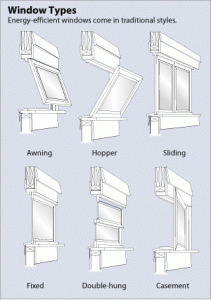Do you have old creaky windows or your winter energy bill outrageously high? Have you recently been considering remodeling your house and replacing your old windows with new energy efficient windows? There are many benefits to replacing your old windows.
How windows lose and gain heat. Windows lose and gain heat by conduction, convection, radiation and air leakage. This heat transfer is expressed with U-values, or U-factors (U-values are the mathematical inverse of R-values. So an R-value of 2 equals a U-value of 1/2, or 0.5). Unlike R-values, lower U-value indicates higher insulating value. Conduction is the movement of heat through a solid material. Radiant transfer is the movement of heat as long-wave heat energy from a warmer body to a cooler body. Air leakage siphons about half of an average home’s heating and cooling energy to the outdoors due to poor weather-stripping or single paned glass windows. For more information on ways windows lose and gain heat check out this website.
Different Types of Energy Efficient Windows. Make sure to check for the Energy Star rating seal when looking to purchase new windows. Here are the different types of windows you can purchase.
- Awning. Hinged at the top and open outward. Because the sash closes by pressing against the frame, they generally have lower air leakage rates than sliding windows.
- Casement. Hinged at the sides. Like awning windows, they generally have lower air leakage rates than sliding windows because the sash closes by pressing against the frame.
- Fixed. Fixed panes that don’t open. When installed properly they’re airtight, but are not suitable in places where window ventilation is desired.
- Hopper. Hinged at the bottom and open inward. Like both awning and casement, they generally have lower air leakage rates because the sash closes by pressing against the frame.
- Single- and double-hung. Both sashes slide vertically in a double-hung window. Only the bottom sash slides upward in a single-hung window. These sliding windows generally have higher air leakage rates than projecting or hinged windows.
- Single- and double-sliding. Both sashes slide horizontally in a double-sliding window. Only one sash slides in a single-sliding window. Like single- and double-hung windows, they generally have higher air leakage rates than projecting or hinged windows.
Energy and Cost Savings. Windows have typically represented a major source of unwanted heat loss and unwanted heat gain, but there has been a major technological revolution. According to National Geographic, “Energy Star estimates that homeowners can save at least $27 a year by replacing windows. If you have single-pane windows, replacing them with Energy Star-qualified products will save you between $126 and $465 a year, depending on the number of windows you replace and where in the United States you live. The cost savings of replacing double-paned windows, however, is less than 25 percent of that amount; the most you can save by replacing double-paned windows is $111 per year”.
Sources: Green Living, Efficient Windows, Energy.gov
